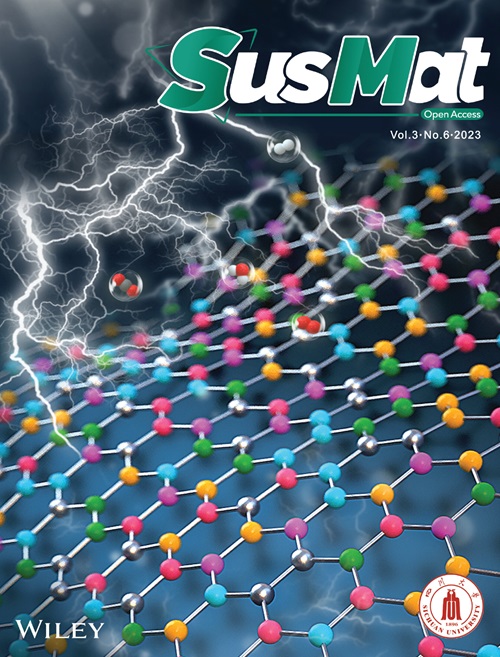Dimensional engineering of covalent organic frameworks derived carbons for electrocatalytic carbon dioxide reduction
IF 18.7
1区 材料科学
Q1 CHEMISTRY, MULTIDISCIPLINARY
引用次数: 0
Abstract
Abstract Covalent organic frameworks (COFs) have been developed as the precursors to construct porous carbons for electrocatalytic systems. However, the influences of carbon dimensions on the catalytic performance are still underexplored. In this work, we have first constructed COF‐derived carbons by template‐synthesis strategy in different dimensions to catalyze the carbon dioxide reduction (CO 2 RR). By using different templates, the one‐dimensional (1D), two‐dimensional (2D), and three‐dimensional (3D) COF‐derived carbons have been employed to anchor Co‐porphyrin to form the Co‐N 5 sites to catalyze CO 2 RR. The 1D catalyst templated by carbon nano tubes presents high binding ability of CO 2 , more defective sites, and higher electronic conductivity, resulting in a higher catalytic activity for CO 2 and selectivity of CO than 2D and 3D carbon‐based catalysts. The 1D catalyst delivers the turnover frequency values of 1150 h −1 and the FECO of 94.5% at 0.7 V versus RHE, which is significantly better than those of 2D and 3D carbon‐based catalysts.用于电催化二氧化碳还原的共价有机框架衍生碳的尺寸工程
摘要共价有机框架(COFs)已成为构建电催化体系多孔碳的前驱体。然而,碳尺寸对催化性能的影响尚未得到充分的研究。在这项工作中,我们首先通过模板合成策略构建了不同维度的COF衍生碳,以催化二氧化碳还原(CO 2 RR)。通过使用不同的模板,利用一维(1D)、二维(2D)和三维(3D) COF衍生碳锚定Co -卟啉,形成Co - n5位点,催化Co 2 RR。碳纳米管模板化的一维催化剂对CO 2的结合能力强,缺陷位点多,电导率高,对CO 2的催化活性和CO的选择性均高于二维和三维碳基催化剂。与RHE相比,在0.7 V下,1D催化剂的周转率为1150 h−1,FECO为94.5%,明显优于2D和3D碳基催化剂。
本文章由计算机程序翻译,如有差异,请以英文原文为准。
求助全文
约1分钟内获得全文
求助全文
来源期刊
自引率
4.20%
发文量
0
期刊介绍:
SusMat aims to publish interdisciplinary and balanced research on sustainable development in various areas including materials science, engineering, chemistry, physics, and ecology. The journal focuses on sustainable materials and their impact on energy and the environment. The topics covered include environment-friendly materials, green catalysis, clean energy, and waste treatment and management. The readership includes materials scientists, engineers, chemists, physicists, energy and environment researchers, and policy makers. The journal is indexed in CAS, Current Contents, DOAJ, Science Citation Index Expanded, and Web of Science. The journal highly values innovative multidisciplinary research with wide impact.

 求助内容:
求助内容: 应助结果提醒方式:
应助结果提醒方式:


